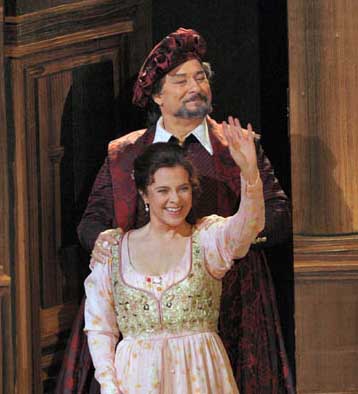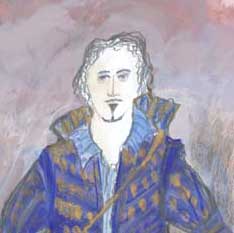Key Word Search
Multi-Field Search
Browse
Repertory Report
Performers Report
Contacts
Met Opera Website
New Production
Roméo et Juliette
Metropolitan Opera House, Mon, November 14, 2005
Debut : Stéphane Degout, David Won, Guy Joosten, Johannes Leiacker, Jorge Jara, Seán Curran, David Cunningham
Roméo et Juliette (301)
Charles Gounod | Jules Barbier/Michel Carré
- Roméo
- Ramón Vargas
- Juliette
- Maureen O'Flynn
- Frère Laurent
- Kristinn Sigmundsson
- Stéphano
- Joyce DiDonato
- Mercutio
- Stéphane Degout [Debut]
- Benvolio
- Tony Stevenson
- Gertrude
- Jane Bunnell
- Capulet
- Frederick Burchinal
- Tybalt
- Dimitri Pittas
- Pâris
- Daniel Sutin
- Grégorio
- David Won [Debut]
- Duke of Verona
- Julien Robbins
- Conductor
- Bertrand de Billy
- Production
- Guy Joosten [Debut]
- Set Designer
- Johannes Leiacker [Debut]
- Costume Designer
- Jorge Jara [Debut]
- Lighting Designer
- David Cunningham [Debut]
- Choreographer
- Seán Curran [Debut]
Roméo et Juliette received eleven performances this season.
Costume Designs by Jorge Jara.
Photograph of Maureen O'Flynn and Frederick Burchinal in Roméo et Juliette by Ken Howard / Metropolitan Opera.
FUNDING:
Production gift of the Gramma Fisher Foundation, Marshalltown, Iowa and The Annenberg Foundation
Additional production gifts from Mr. and Mrs. Sid R. Bass, Hermione Foundation, Karen and Kevin Kennedy, Mr. and Mrs. William R. Miller, Bill Rollnick and Nancy Ellison Rollnick, Mr. and Mrs. Ezra K. Zilkha
Review 1:
Review of David J. Baker in the February 2006 issue of OPERA NEWS
Director Guy Joosten has given the Met a new "Roméo et Juliette" that succeeds most fully when it adheres to basics. Gounod's indestructible yet fragile work remains a place where the fundamental things apply, as the director mostly seems to understand. With the help of set designer Johannes Leiacker (making a Met debut, like the rest of the visual team), the production develops a sharp opposition between the specifics of Renaissance Italian city life and the timeless, super terrestrial realm of romance. For the love scenes, urban architecture splits apart to reveal the starry cosmos. In Act II, occurring outside Juliette's window, Leiacker's dazzling night sky seems perfectly attuned to the undulating prelude spun out with great poise by conductor Bertrand de Billy and the responsive Met strings, and the mood is sustained in the long-phrased ardor Ramón Vargas brings to the hero's music.
The designer later overloads the concept, filling the circular backdrop with items relevant and otherwise. A giant clock obscures the heavens as Juliette is led to the altar with Count Pâris; an eclipse appears in one scene, then busy stairways in a jarring DeChirico knockoff, and at one point a mound that might be a moon close-up or maybe some rounded human body part.
Most of the sets, though, are eye-catching (especially in comparison with the superannuated 1967 production that the company kept in its repertory through the 1997-98 season) and the blocking of chorus members in costume designer Jorge Jara's richly assorted shades of red provides effective tableaux.
The chief miscalculation is heavy-handed realism. True, the fight scenes, aided by the revolving stage, are sharp and scary, and Gertrude (Jane Bunnell), Frère Laurent (Kristinn Siegmundsson) and Capulet (Frederick Burchinal) commit some appropriate Shakespearean buffooneries. But Roméo and Juliette themselves should not be asked to provide realistic comic relief.
From the start, these two are shown breaking one another up. Both roll on the ground at the end of Juliette's waltz song. They joust with their masks and, during the balcony scene of all places, resort to sitcom-style gestures and grimaces. With Vargas playing against type - and with the gymnastic, ebullient Natalie Dessay, for whom this production was conceived, unexpectedly absent on [the first] night due to illness, leaving her cover, Maureen O'Flynn, to negotiate Juliette's moves with understandable hesitation - the juvenile clowning did not stand a chance. The attempted erotic display on an elevated bed in Act III fared not much better.
Fortunately, the musical standard was high. De Billy's brisk tempos worked wonders in passages that can sound repetitive and formulaic, and his expansive phrasing illuminated the lyrical elements. O'Flynn sang fluently, brightly and with ample force for her dramatic utterances, though she tired in the high-lying flourishes of her final aria, a treacherous and not very rewarding number that is often omitted. What one missed was the charisma that alone can compensate for a role lacking in real musical interest.
Vargas had the warmth, brightness and elegant legato required of Romèo, almost
making one overlook some awkward French diction and occasional forced tone. In Act II's "Ah! Lève-toi, soleil," in particular, although he disregarded the score's dynamic markings, certain cantilena phrases had real distinction, and the crowning B-flats were exciting. The supporting cast sang handsomely, though Joyce DiDonato, as a vibrant mezzo Stéphano, tended to push her upper register unpleasantly. Baritone Stéphane Degout, the Mercutio, showed strength as a singing actor in his company debut.
*(See November 21, 2005 for
Review 2:Review of Dessay as Juliette).
Search by season: 2005-06
Search by title: Roméo et Juliette,
Met careers
- Bertrand de Billy [Conductor]
- Ramón Vargas [Roméo]
- Maureen O'Flynn [Juliette]
- Kristinn Sigmundsson [Frère Laurent]
- Joyce DiDonato [Stéphano]
- Stéphane Degout [Mercutio]
- Tony Stevenson [Benvolio]
- Jane Bunnell [Gertrude]
- Frederick Burchinal [Capulet]
- Dimitri Pittas [Tybalt]
- Daniel Sutin [Pâris]
- David Won [Grégorio]
- Julien Robbins [Duke of Verona]
- Guy Joosten [Production]
- Johannes Leiacker [Set Designer]
- Jorge Jara [Costume Designer]
- Seán Curran [Choreographer]
- David Cunningham [Lighting Designer]

